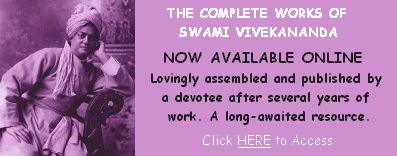

 Listen to a 60 second rendition of the Gayatri Mantra
Listen to a 60 second rendition of the Gayatri Mantra 



|
Glossary:Narendra = Narendranath = Naren = Swami Vivekananda Master = Thakur = Sri Ramakrishna Dr. C. S. Shah Regret to inform you that father passed away on 24th Apr 2004 leaving his fond memories and imprints on my heart. Shantanu [Dr C S Shah's son] Sri Ramakrishna knew that Swami Vivekananda was ever-perfected soul - nitya siddha - in meditation. Change of Views After this meeting Narendra was forced to change many of his preconceived notions about God, divinity, and perfected souls. He had formerly great objection, as most of us have, to accept another man as Guru or spiritual guide. This is because we think that the person whom we accept as Guru might turn out to be an ordinary man full of inherent weakness of lust and gold. But on coming in the company of Sri Ramakrishna, Narendra understood that such great souls with complete renunciation, selflessness, and compassion, though rare, actually are born in the world - souls with extraordinary purity, love, and penance - that shake the limited conception about God and God-Man existing in the little mind and intellect of we ordinary people. Therefore, if they are accepted as Gurus, ordinary men will be benefited, and not harmed. Consequently Narendra was ready to accept the Master as his Guru, but still he could not go so far as to accept indiscriminately whatever Sri Ramakrishna said! As Swami Saradananda writes, "A powerful mind feels strong resistance from within when, at the time of accepting new truth, it has to change its former convictions. Narendranath was in that predicament. Though acquainted with the Master's wonderful power, he could not completely accept him, and though feeling attracted, he tried to stand aloof from him." * Naren started visiting the Master more frequently. Soon he got acquainted with a few more sincere disciples who had already decided to dedicate their lives at the Holy feet of Sri Ramakrishna. These meetings with the Master were full of fun and joy, pleasure and gaiety, and there was never even the shadow of gloom, dejection, despair, or worry. It was always 'Ananda Mela' (mart of pleasure) at Dakshineswar. Sri Ramakrishna used to 'teach' in simple language through parables and stories. There was never a feeling that the Master was the Guru, but mostly all looked upon him as their wise friend with huge spiritual knowledge borne out of innumerable direct personal experiences. A few of the disciples visited him daily, others at varying interval per week. There was no restriction or compulsion on any one, but Thakur used to emphasis about the importance of love for God, austerities, sadhana, renunciation, continence, and purity to get the spiritual insights. Besides these sincere 'monk like' disciples belonging to 'inner circle', many householder devotees, sadhus, fakirs, and lay people used to visit Kali Temple daily, and also met Sri Ramakrishna who used to live in one of the rooms nearby. (It is worth visiting the Kali temple and Dakshineswar, once in lifetime where as recently as 115 years back the great child of the Mother realized Her Living presence in that 'stone idol'!) Continued part 8... The Teachings of Vedanta Through the talks and stories, parables and devotional music and singing (bhajana and kirtana) concerning Sri Krishna, Radha, Gopis of Vrindavan, and Mother Kali and Chaitannya, Narendra came to know the essence of religion as 'Realization of the highest Truth' in our lives. As he was opposed/reluctant to idol/image worship, and believed in non-dual form of God, Thakur explained him the subtle points about Brahma, Atman, and Unified Consciousness - the one without the second. Thus, the Master persuaded Narendra to read to him Ashtavakra Gita and similar texts on Advaita Vedanta, explaining finer points, which were difficult to comprehend. Sri Ramakrishna preferred to tell these nuances in total privacy, when no one other than themselves would be present in the room. It was all Jnana and Yoga to begin with. Later Bhakti and Karma Yoga were added, so to so, which we shall subsequently touch upon. The Master also instructed his disciples about the importance, ways, methods, and means about mediation and spiritual disciplines. Thus, between 1881 and 1886, for five years, Narendra was groomed to become a great yogi with unparalleled sharpness of intellect, reason, and logic. No one could stand his incisive power of critical analysis based on scientific reason and rationality in the matters of Vedanta. Added to this was the gracious gift of the Master to his beloved Naren, the gift of Nirvikalpa Samadhi -highest non-dual consciousness- through which Swami Vivekananda realized the Truths of superconscious states. He was face to face with Atman, the God of the Master. Therefore, as is said, 'nothing else remained for Swami Vivekananda to realize now'. He had realized the highest Truth! But was that the case, indeed! No! For, he still had to realize the truth of Mother, that impersonal and personal aspects of God are one and the same like Shiva and Shakti, the two sides of the same coin. God with attributes and form and God without attributes and form had relationship like that of fire and its power to burn, sun and its rays, milk and its whiteness, or diamond and its luster. One can't be separated from the other. This unity in duality (which likewise can be extended to unity in universal diversity) is in fact the successive stages in realization of the ultimate Single Truth, which Swami Vivekananda later elaborated in one of lectures in the USA as, "It is like taking photographs of the sun from different locations and stations in orbit; all the photographs would appear different, but the essence would be the one, SUN!" Learning Through Hardships Three episodes during the interaction between the Master and Narendra during the period between 1884 and 1886 are worth recounting. Death of Narendra's father and his subsequent prayer to Ma Kali, The invaluable mantra "Shiva Jnane Jiva Seva" (serving every being as the full manifestation of God) that Narendranath received from his Master, Sri Ramakrishna's terminal ailment Death of Narendra's father and his subsequent prayer to Ma Kali No one knows the ways of divine play! Inscrutable are the ways of the Lord that only a few can understand; others call it fate! Such a life shattering event occurred in the life of Swami Vivekananda when he had passed his degree course in the college, and when was about 21 years of age. Everything was going on smoothly for him at home and at Dakshineswar, when his father suddenly died due to massive heart attack. The liberal attorney, Vishwanath Dutta, although outwardly appeared well off, in fact was in severe debt. His unusual generosity and carelessness in handling the money matters had put him in a situation where nothing was felt as the savings. The debtors took away their share leaving the bereaved family in utter poverty and want. Narendra's uncles also shied away in this hour of crisis, and instead of helping him they took their share and kept aloof. It was difficult for Narendra to make two ends meet. To add to the difficulty, Narendra could not get a job even after trying hard. In this situation of utter emergency and despair, Swami Vivekananda took the decision to leave the home and walk out in the unknown world as a sannyasin. Here at Dakshineswar Sri Ramakrishna in his spiritual mood came to know about the secret resolve of his beloved disciple, which caused much anguish and concern in his heart. In such a situation the Master met Narendra at one of the devotee's house. In his deep emotional voice, the Master sang a song, which ran like this, "I am afraid to speak, and equally afraid not to speak, The doubt rises in my mind, Lest I should lose you, Ah my Rai, Lest I should lose you" Immediately the meaning was clear to Narendra; he knew that Sri Ramakrishna had come to know his secret resolve to become the sannyasin, and that the song was meant for him to reconsider his decision. Tears flowed down the cheeks of both the Guru and the disciple wetting their chests as well. All other devotees present there were surprised to see such an unusual behaviour of the Master and Narendranath; no one knowing the real cause behind this emotional outburst. After some time the emotions smoothened and Sri Ramakrishna forced Swami Vivekananda to accompany him to Dakshineswar. There Sri Ramakrishna inquired about the problem and requested Naren not to desert him till his death. Narendra had to promise, for he could not disobey the sincerity in Master's appeal. Then Swami Vivekananda said to Sri Ramakrishna, "O Sir, please pray to the Mother so that my family is supplied with coarse grain and clothes. I know the Mother listens to you and definitely grants your prayers." But the Master had different plans, if we can say so. Sri Ramakrishna said, "Look my boy, I have given everything to the Mother; how can I ask back anything from her now? But one thing I can tell you, why don't you go and pray to the Mother to fulfill you wish? My Mother is very kind and gracious, and I am sure she will not disappoint you." Thus, Swami Vivekananda was forced to pray to the Mother to fulfill his wants. That night Narendra and the Master were alone in the kali Temple, when Swami Vivekananda went to the Mother's shrine to pray and ask for material things of urgent necessity. However, as he entered the shrine all that he could say was, "O Mother, please give me Jnana and Bhakti." Thus praying Narendra returned back to where Sri Ramakrishna was standing. The Master inquired, "Naren, have you asked for food and money required for your family?" Swami Vivekananda, surprised he was as well, replied, "Why, no sir! I asked for Jnana and Bhakti." "You fool," said the Master, "Go and ask for wealth and the things you actually need now." Thrice Swami Vivekananda went to Ma Kali, but could not utter the word about money, clothes, food, and instead all the three times he prayed to the Mother to grant him Jnana and Bhakti! As soon as Swami Vivekananda used to enter the temple, he was elevated to such a wonderful state of mind and consciousness that the whole world including money, material comfort, and food lost all their value, and in its place there shone forth the face of divine and blissful Mother gracious enough to grant highest Jnana and Bhakti! Who fool would ask for transient and useless things when in fact the Mother was granting Jnana! Who would ask for pebbles when someone was distributing the gems! Who would ask for vegetables to the king, when he was willing to grant his whole kingdom! Now Swami Vivekananda understood the deep meaning and significance of his Master's word that formless god and God with form as the Mother were but one. Swami Vivekananda accepted the Mother on that day as the highest embodiment of spiritual virtues, power, and knowledge. Exhausted, but satiated with inner knowledge of divinity in all its aspects, he bowed down at the holy feet of the Master and prayed, "O Lord, today I came to know who you are. You are all, everything in this universe. I do not want anything anymore from the Mother. It is all your wish." Embracing his disciple, the master assured, "Go my son, be at peace. From today onwards you and your family would ever be provided with simple clothes and food, and shelter. This much I guarantee for you and your family." Shiva Jnane Jiva Seva The invaluable mantra "Shiva Jnane Jiva Seva" (serving every being as the full manifestation of God) that Narendranath received from his Master Narendra had developed peculiar sharpness of perception and assimilation that empowered him with peculiar power to pick up 'the gems' from the talks of the Master. He could, as compared to others, 'see' the deep meaning in the words of Sri Ramakrishna, even though the Master told them in simple language, and never as preaching. Thus, gradually Swami Vivekananda was assimilating the tips and hints about practical Vedanta that could be put into individual and collective life in the society. For instance, sometime in 1884, once the Master was sitting in the room surrounded by his devotees including Narendranath. In the course of conversation arose the topic of Vaishnava religion, and explaining the essence of that doctrine the Master said, "That doctrine teaches that one should always be careful to observe three things, namely, a taste for God's name, kindness to all beings, and the service of co-devotees. ...One should have the conviction in one's heart that the whole universe belongs to Krishna, and therefore, one should have compassion for all beings." No sooner had Sri Ramakrishna uttered the words " compassion for all beings" than he suddenly went into ecstasy. Regaining partial normal consciousness, he continued, "Talk of compassion for beings! Insignificant creature that you are, how can you show compassion for all beings? Who are you to show compassion? You wretch, who are you to bestow it! No, no; it is not compassion to jives, but service to them as Shiva." All went on listening to those words of the Master spoken in that ecstatic mood, but none could detect and understand their hidden import at that time. It was Narendranath alone who, coming out of the room at the end of Master's ecstasy, said, "Ah, what a wonderful light have I got today from the Master's words! What a new and attractive Gospel have we received today through those words of his, wherein a synthesis has been effected of sweet devotion to the Lord with Vedantic knowledge, which is generally regarded as dry austere and lacking in sympathy with the suffering of others. Whenever shall I get the opportunity I will preach this wonderful doctrine of 'Shiva Jnane Jiva Seva', serving God in each living being! To give an example how in later life Swami Vivekananda actually put this mantra in practice, the following incidence is worth mentioning: After his return from USA around 1898, Swami Vivekananda had acquired land at Belur for construction of the Temple of Sri Ramakrishna and the Math for sannyasins. He was not keeping well and had gone to Darjeeling hill station for rest. Meanwhile an epidemic of plague broke out in Calcutta; the panic set in all over. People were running in fear, leaving Calcutta. Many died and there was no one to take care of the sick or dispose of the dead bodies. The news reached the broad-hearted Swami who immediately returned to Calcutta and ordered all the inmates of Belur Math to get busy in the service and care of the affected. Many a sannyasin protested, 'this is not our work; Sri Ramakrishna had never told us social service. Our main aim is to seek the God and do sadhana.' This was the argument put forward by some of the sannyasins. Swami Vivekananda thundered at them saying, "O my brothers, have you forgotten the mantra of our Master! 'Shiva Jnane Jiva Seva'! By serving human beings we are serving the highest expression of the God on this earth. Love the Lord in these suffering patients. I appeal to you to come forward in this calamity and serve the living God. All the monks were stunned to listen to these powerful words of their leader and many of them saw the truth therein. But someone still protested, "O swami, from where the money would come?" To this the Swami retaliated, "If need be, sell off the Belur Math! The money thus gathered would be put to the service of these men. I care not for home or shelter for ourselves; we are sannyasins, and we have taken the vow of poverty. Tree shade would be our roof and a loin cloth would be enough for us to cover our bodies." Thus were engaged all the monks, householder devotees of Thakur, and inmates of Belur Math in the service of the afflicted. The British authorities in their report on the epidemic had recorded that due to this timely help from the Math mortality was less and moreover, the epidemic was brought under control much quicker! The Master Departs In the month of October 1885 Sri Ramakrishna developed throat ailment, which subsequently proved to be incurable cancer of throat. The doctors gave up any hope of recovery, and there was for the first time an atmosphere of gloom, anxiety, and worry at Dakshineswar. Swami Vivekananda organized the team of his fellow brothers and devotees to take due care of the Master. Timetables were set up so that some one would always be available for providing necessary help to Thakur and Ma Saradadevi. The householder devotees on their part offered monetary and material help for Thakur's nursing care, medicines, and food. |




  |

Interesting Places to Visit
Swami Vivekananda - the Universal Man - Part3
Quotes from Sri Swami Vivekananda
RK Digest Chatroom and Message Board
Another Sri Swami Vivekananda Site
Visit Site dedicated to the Holy Mother
Visit site dedicated to "M", Author of Gospel of Sri Ramakrishna
Visit Sri Sri Ramakrishna Paramahamsadeva Site
Visit DAKSHINESWAR temple near Calcutta
SRI SARADA NAHABAT GUESTBOOK
Vedanta Society of Toronto
Visit the RAMAKRISHNA MATH at Chennai, India
DAILY SUTRAS collected and prepared by EM Hashim
Sanscrit Etymological Sources






